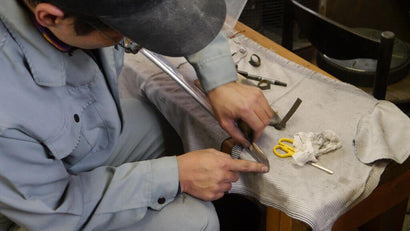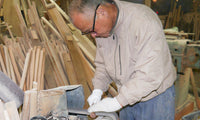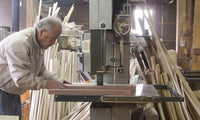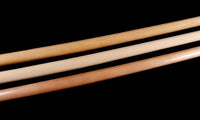The origin and manufacture of the Iaito, replica of the Japanese sword, the Katana
Visits to the workshops Minosaka and Jisei
The origin of the Iaito does not date back very far, to the 60s or so. The creation of this tool for practice was primarily driven by new laws and regulations, enacted after World War ll. Since then, with the experience of many trades in the manufacture of the Nihonto (Japanese sword), some Japanese craftsmen have developed an expertise, still unparalleled outside the archipelago.
We went to the region called Gifu to visit the workshops Minosaka and Nihon Token (Jisei), two of the most famous in Japan. Familiar with this topic for some years, we had many questions to ask – which we are summarizing here.

Ban on the carrying of weapons
In 1958, relating to the new pacifist policy of Japan, a series of highly restrictive laws on carrying weapons was passed by the Japanese government. It became illegal to carry and transport anything that might resemble a weapon, whether a firearm or a simple kitchen knife, and further the manufacture of bladed weapons got heavily regulated and strictly controlled.
The Japanese Katana, also known as Nihonto, was put in a special category for the preservation of ancient arts and traditions, and its manufacture did not get prohibited. However, the regulations are strict and only forgers approved by the government are authorized to manufacture them, respecting relatively severe quotas. The manufacture of steel swords, machetes, as well as a number of other weapons of this type became totally prohibited outside the framework described above. It got also prohibited to make any blade that could be transformed into a sharp weapon. These new laws are very technical, but concerning the swords the result is simple: The production of unsharpened steel swords is prohibited, for the simple reason that a grinding wheel would be enough to turn it into a cutting weapon.
This set of laws probably benefited Japan, although until the end of the sixties, the country was not as peaceful as today (I am referring to some of the most violent riots of the 68 Movement). It remains to this day, that Japan is one of the countries with the lowest crime rate in the world, it is almost impossible to find a gun, extremely difficult to find a weapon more dangerous than a kitchen knife. We could even go as far as to think that these laws and the philosophy that accompany them, have also caused profound changes in the practice of modern martial arts – but this is another topic which deserves a thorough article.
Note that the possession of a Nihonto is allowed only if it is duly registered at the relevant police station of the place of residence and if the mentioned object meets a set of criteria placing it in the category of “objects of art”. The transport of the Nihonto is theoretically not allowed, but tolerated to some extent if it is justified, and the registration documents always have to be with the weapon.

Recording example of a Tanto (Source)
The origin of the Iaito
Based on these facts, the Iaido practitioners had to find a solution to continue their training. Since the beginning of the Meiji era, the Kenjtsu and the Iai lost popularity and the artisans of the industry suffered as much as the different schools have struggled to survive at that time. While by the end of the Second World War, western sports became increasingly important, and the stigma of war did not motivate the Japanese to turn to the “art of war”, the practice of the sword. At a time when the laws did not facilitate the work of the artisans in this sector, a craftsman of the Fukuoka region still had the idea to design the Iaito. Indeed, the few remaining practitioners still needed a sword to practice! The first Iaito was composed of a rather basic but strong alloy blade, that could not be sharpened, and of Kanagu, once intended for Nihonto. The quality was not yet convincing and it took several decades to make the Iaito become a faithful replica of the Nihonto, where only the blade is modified to adapt to the regulations.
It was during a trip to the region of Gifu to meet the artisans of the sector, that the idea sprout in the mind of the designer of the first Iaito. Unfortunately, the first workshop in Fukuoka failed and it was, some years later (early 1970), in the region of Gifu, where gradually all Iaito workshops developed.
Hence, the entire production of Japanese Iaito is shared between 4 (or maybe 5) workshops.
Why Gifu ? Gifu historically corresponds to one of the five major traditional forging school, called Mino school. It is the only one situated in an area where iron ore can not be found and although the region’s forgers worked the famous Tamagahane on site, they had to import the ore from other regions. However, this was the only school that survived to this day. Why? Without being categorical, the forger as well as the Iaito workshops think that this was thanks to their work organization. An organization that was particularly excellent in terms of the synergy between the various actors of the sword production, from the blade to the Kanagu and the Saya. This synergy has allowed local artisans to survive the Meiji era, when the sword totally fell into disuse, what caused the end of almost all craftsmen and smiths of the pre-Meiji period. Furthermore, the region of Gifu is renowned for producing the best “Honoki” all over Japan – Magnolia wood used especially for the Saya and the Tsuka. It is therefore natural that the manufacture of the Iaito settled in this region, where craft traditions had been preserved.
Misconceptions
We often hear that the Iaito is too light and that therefore the practice is can not be compare to the practice with a sword made from steel. Is this a popular opinion or the outcome of marketing campaigns made by many non-Japanese companies producing low-end steel “Iaito” – I do not know. What is certain, however, is that these assertions are false. The weight of a Iaito is generally between 750 and 1200 g, while the average weight of a Nihonto of comparable size is around 900 to 1200 g. Of course, one can argue that 750 g is low. This was actually requested by Iaido practitioners, to make the practice of the Kata easier. For cutting preparation training (Tameshigiri or Batto), one would rather choose a heavier Iaito, one around 1000 g. (The comparison refer to fairly modern blades from Edo period to the one produced today. Far heavier blades have been produced in the past, but actual Iaito are not meant to reproduce those blades).
It is absolutely possible to alter the balance of a Iaito by various processes, as this is done for the Shinken. Indeed, the Iaito used for cutting exercises are often without groove, for reasons of strength, but it is also possible to make a Iaito without a groove to make it even heavier than many sharp Katana used for the Iai practice (you understand where I’m going here). On the Iaito, the balance point is generally on the Tsuba, simply because that is what is required by most practitioners. The Iaito is hence less difficult to handle, the performance of a Iai or Kenjutsu Kata is made easier. This is by the way the reason why many schools encourage their students to do cutting practice, so as to feel the difference to the Katana. Let us be clear: a practitioner of Iaido or Kenjutsu is not going to start cutting exercises after his first three courses. The “standard” Iaito are easier to handle and are in the opinion of the vast majority of teachers, perfect for beginners.

Custom made Jisei Iaito, with Kogatana on the Saya
How to make a Iaito
The Iaito thus consists of a casted aluminium alloy, a Tsuka with its braiding, a set of Kanagu (Tsuba, Fuchi, Kashira, Menuki), and a lacquered Saya.
No matter which workshop builds the Iaito, all blades are from the same foundry, located in the region of Gifu. Depending on the workshops, alloys and dimensions of the blades may however vary slightly and the foundry meets the specific demands of each workshop.
The crude blades are then polished between 8 and 16 times with sandpaper, depending on the desired quality of the finish. This process is particularly long, especially with regard to the groove, or for some finishes, the “wheels” can not be used and the grinding is finished by hand (it can take up to 4 hours to manually complete a groove on a very high-end model). From there, the blade gets plated to protect it from scratches and rust, done directly at a workshop specialized in this process. At this stage, so that the blade can be immersed in the chromium bath, a hole is drilled in the Nakago (the part of the blade that is later covered by the handle), which will be called “Mekki-Ana” (plating hole). This hole is a specificity of the Iaito, since this process does not exist in case of a steel blade. Finally, the Hamon is roughened (sand paper) in the last blade manufacturing step. There are hundreds of designs divided into about 20 groups, so as to obtain different results even for the same Hamon.

Etching the Hamon

Groove finish with sand paper
From a technical point of view, the Kanagu – mainly the Tsuba, Fuchi, Kashira and Menuki, are divided into two classes: the “molded” Kanagu and the hand carved Kanagu. Made from copper, aluminium, wrought iron, horn, or gold and silver: the material is either to be left raw or finished through various processes, such as oxidation, fumigation, or exposure to heat, obtaining an antique look, or a total or partial plaiting of gold or silver.
Of course, the molded Kanagu, although still finished by hand, are much cheaper than the entirely hand crafted ones. As part of the manufacture of Iaito or restoring old (but not very precious) swords, for reasons of cost, the molded Kanagu are preferred, but some high-end Iaito feature these traditionally sculpted Kanagu.
The Tsuka braiding is traditionally made of cotton, silk or leather, and carried out by a specialist, the Tsukashi.
Under this braiding is a piece of shark skin, or “Samekawa” usually white or black. On a Shinken, the Samekawa completely encloses the Tsuka, on a Iaito there are only two small pieces fixed under the braiding of the visible part of the Tsuka, this again for reasons of cost.
The Tsuka is, like the Saya, made of Japanese Magnolia, “Magnolia obavata“. Solid but light and easy to work, makes it an excellent wood for the Saya.
The Saya were originally painted with “Urushi”, a highly allergenic liquid plant lacquer, that has been widely used for millennia in all sectors of Japanese art. By adding various components to the Urushi, the color can be changed: This search for a specific color is what characterizes, even today, the lacquerer artisans. Today, the Saya are often finished with a urethane compound, stronger and easier to work with than the Urushi. However, as for the Kanagu, the high-end Saya, also in the manufacture of Iaito, are still coated with Urushi.

Jisei – A Menuki designed to celebrate the year of the horse (2014). Every Menuki represents 6 of the 12 Chinese Zodiac signs,
the horse is gold plated and the mouse, the opposite sign, is silver plated.
You will understand that the components used in the manufacture of the Iaito are not quite the same as for the manufacture of the Shinken. Iaito blades are standardized, which allows to have in advance a stock of Saya, Tsuka and Kanagu (including Habaki and Seppa) for, when receiving an order, only having to finish the polishing of the blade and the Hamon and assemble the Iaito.
This process makes it possible to complete a Iaito within a few days for the most basic models (although the actual process may take longer depending on the craftsman’s workload), and a rate of 300 to $1,000. Comparing to the restoration of a sword for which the Koshirae is handmade and made to measure, (given the fact that these blades are not standardized), it takes about 2-4 months, depending on the availability of the artisans and the level of the desired finish. The simple painting of the Saya can take up to five weeks, because drying time of each layer. And the price, excluding the blade, varies between 2.000 and $3.000 for a “standard” mount.
The artisans we met, sometimes manufacture Iaito identical to a Shinken (sometimes they even copy the sharp Tamahagane blade to make an exact aluminium copy). The process can take up to six months and costs about $ 3.000 (and can be much higher depending on the type of Kanagu that have to be copied). Thanks to this, teachers can travel to some countries and teach with a blade identical to that of their usual sword, that would not be allowed to enter the country.
Minosaka and Nihon Token
Minosaka and Nihon Token are workshops that established in the 1970s and whose first leaders were craftsmen specialized in metal work. Their encounter with the mentioned artisan from Fukuoka who was the first to conceive the idea of Shinken replicas for the Iai training, and their connections made it possible to set up a network of artisans producing all the various parts used in the manufacture of the Iaito and this allowed them to build their workshops on solid foundations.
The entirely hand made manufacturing at the beginning turned out to be too expensive for swords only used for training, and a few years of research were needed to obtain alloys to manufacture the Iaito as we know it today. It was in the 1980s that the quality we can appreciate today is reached.
Of course, over the years and based on the practitioners’ requests, numerous attempts were made to change the alloys used, and although some improvements have been retained, the zinc-aluminum compound in its proportions (confidential) used today seems to be the one that best meets the practitioners` needs.
The work of these workshops is not limited to the manufacture and assembly of the Iaito: they also have to design the Koshirae. This involves historical research on the different trends depending on the era, the material used, the artistic subjects explored by the craftsmen, etc.
Thus, we often find the terms “Jidai” referring to the major trends of Medieval Japan, “Higo” representing a synthesis of the trends of the region Higo no Kuni (now called Kumamoto), or “Tensho” referring to the Tensho era (16th century), etc.
By the same reasoning, the Kanagu were named either after the clan or the famous Samurai who used the model, or simply after what the object represented. The Hamon are also copied from historical swords and can correspond to a relatively vague trend, but also be an exact replica of a famous sword, or “style” of a particular forger.
Naming the elements rooted in a collaboration between artisans and historians. From a technical point of view, many things are possible, and the evolution of this craft should not remain frozen in the name of a “over-sacred” history, rather to set limits between what is historically acceptable and what is not.
The Hamon is a good example of potential abuse. Nowadays, it is possible to create any pattern on an alloy blade, originally the Hamon was obtained by selective hardening of the steel and depended on both, the polishing, but also the work of the forger and therefore of the structure of the blade. Some of the Iaito Hamon designs are completely inconceivable because physically unattainable with a Tamahagane sword. This is where we reach a limit that is not to cross in the manufacture of the Iaito, if the Iaito should be a faithful replica of the Nihonto.

The Minosaka (left) and the Jisei (right) Workshop
Minosaka (picture on the left) internalizes much of the manufacturing process and limits the available options, especially in terms of the choice of the Kanagu and the blade types. This allows them a faster production time and an easier management of the workshop. In the late 80s, the founder of the Minosaka workshop – tired of all the years of craft work – retires to pursue his passion: cooking. He handed Minosaka over to the most competent craftsmen, Mr. Wakihara. With the help of various shops trading their products, Minosaka has gradually become a recognized brand of quality. Today, Minosaka produces about 20 pieces per day. You can find the Custom Made Minosaka Iaito Series on SeidoShop.
On the other hand, Nihon Token (picture on the right) almost fully outsources the production of the different elements. Their job is to design the Koshirae, to control the quality of the craftsmen’s work and finally the assembling of the Iaito. These assemblers are also trained in various manufacturing processes to be versatile when needed.
Until recently, Nihon Token produced their Iaito unbranded and provided numerous shops and more or less known Japanese brands. In 2009, Nihon Token decided to register the trade mark Jisei. The head of Jisei, Mr. Isobe, is the designer of the Koshirae sold under this brand. Jisei manufactures about 30 to 40 pieces per day (a carefully selected range will be available in a few months on SeidoShop). (Update: they are now available here).
As in many areas strongly connected to the Japanese traditions, the milieu of the Iaito and Nihonto manufacturers is very closed. Getting to know and meet the artisans helped to realize how huge the gap is between the greatest humility of the craftsmen and the commercial thinking of the distributors. Mr. Isobe told us that until the creation of Jisei, very few shops actually knew what they were selling. Jisei was the first shop directly dependent on a workshop and the work of Mr. Isobe consisted and still consists of providing very specific information to practitioners and clients. This helped to shake up a little bit the environment and pushed some stores to do some proper research and learn about the products they offer. This mindset is also one of the founding principles of Seido, that is what allowed us to approach and win Mr. Isobe’s trust.
It is important to note that the mechanical quality, i.e. the balance and the strength of the blade and the assembly of the Minosaka Iaito are similar to the Jisei Iaito. The difference lies mainly in the working mode of each workshop, and artistic choices of the craftsmen. Although one can notice very slight specialities such as a better finish of the groove on swords manufactured by Jisei’s, and a better finish Yokote (point) on swords manufactured by Minosaka, the overall differences are minimal.
The Nihonto
Traditional sword made of Japanese steel, the Tamahagane, the Nihonto is the symbol of a whole part of the Japanese culture. Its history, its mythology, its manufacturing process and its legends have transformed it into a mystical object of fantasy, in Japanese as well as in western culture.
The quality of the Nihonto was actually very variable, depending on the time period and according to the means of its owner. Today it can be estimated that a majority of swords made during the Edo period were not intended for fighting and probably never used. At that time, and despite the peace that lasted for 200 years, nearly 10% of the population were part of the Samurai class, actually Samurai officials who, when carrying a sword, often had a ceremonial one, sharpened of course, but absolutely not meant to be taken out of its Saya.
You can also take the example of the Gunto, the military swords, whose quality has fluctuated widely according to the finances of the state.

Nihonto – Blade made by forger master Hizen Tadayashi, période Edo (1613).
Presented at the Tokyo National Museum (Ueno).
A new Nihonto now costs more than a usable antique one (particularly because of the quotas mentioned earlier in this article). It costs, including the blade and the Koshirae, a minimum of 6000 to 8000 $, a historical one “usable” between 4000 and 6000 $ (this can of course go up much higher).
Check our interview-reportage at the Minosaka Workshop
Glossary of the terms used in this article
- Katana, « 刀 » : Sword : denotes a Japanese sword. Generic term.
- Shinken, « 真剣 » : Real sword : denotes an edged sword. (Made in Japan or not).
- Nihonto, « 日本刀 » : Japanese sword : denotes a sword made in Japan.
- Shinsakuto, « 新作刀 » : New sword : denotes a sword manufactured today (in Japan or not).
- Iaito, « 居合刀 » : Iai sword : denotes a sword used for Iaido practice.
- Mozoto « 模造刀 » or Mogito, « 模擬刀 » : Sword imitation.
- Koshirae, « 拵え » : preparation or arrangement: denotes the general arrangement of the style of a sword (except the blade).
- Tsuka, « 柄 » : Handle : the guard, (including or not the Fuchi and the Kashira).
- Tsukaito, « 柄糸 » : Handle – wire/cord : means the cord wrapped around the Tsuka.
- Samekawa, « 鮫川 » : shark-skin : refers to the shark skin around the Tsuka, hold by the Tsukaito.
- Menuki, « 目貫 » : “eye-hole” : means the decorative parts usually attached to the Samekawa, fixed under the Tsukaito, made to distract from the Mekugi (the not very aesthetic pin for securing the blade to the Tsuka).
- Tsuba, « 鍔 » : guard
- Fuchi, « 縁 » : connection : decorative piece, connecting the Tsuka to the Tsuba.
- Kashira, « 頭 » : head : means the part attached to the pommel of the Tsuka.
- Saya, « 鞘 » : scabbard
- Urushi, « 漆 » : Lacquer (especially the lacquer from the Toxicodendron vernicifluum )
- Tamahagane, « 玉鋼 » : jewel – steel : denotes the high quality steel used in the manufacture of the Nihonto.
- The 5 forger traditions «五ヶ伝 » : the 5 major traditional centers (regions), Bizen, Mino (now region of Gifu), Soshu, Yamashiro and Yamato.
This article is an enhanced transcription of the article we published in the French magazine “Dragon Spécial Aikido HS N°4” (ISSN 2261-1134, april 2014), translated for the Seido Blog.






5 comments - The origin and manufacture of the Iaito
I have an older Iaito that I’ve been using for Iai-jutsu, it seems to be well made, has good balance and weight, and a nicely made kissaki. However the company that used to sell the model no longer does so and has no information on it. Since it’s an older sword I have concerns about the durability of the metal. Are there any ways I can find out the type of alloy used or otherwise check that it’s not about to fall apart?
If I want a custom saya for my katana, can you do it?
Gusto en saludarlos, me interesa adquirir un Iaito y les solicito su ayuda para saber acerca de las directrices para elegir.
Saludos y atento a sus observaciones.
In reply to Andres Guerrero Yanez.
Thanks for your comment Andres.
I’m sorry, but we do not have support in Spanish. You can send your inquiry in English, French, German or Japanese using contact form and we’ll get back to you asap.
A very nice information about how to keep our swords blade sharp and intact. Swords looks beautiful when they are kept sharp. When their blades are sharp and shiny.